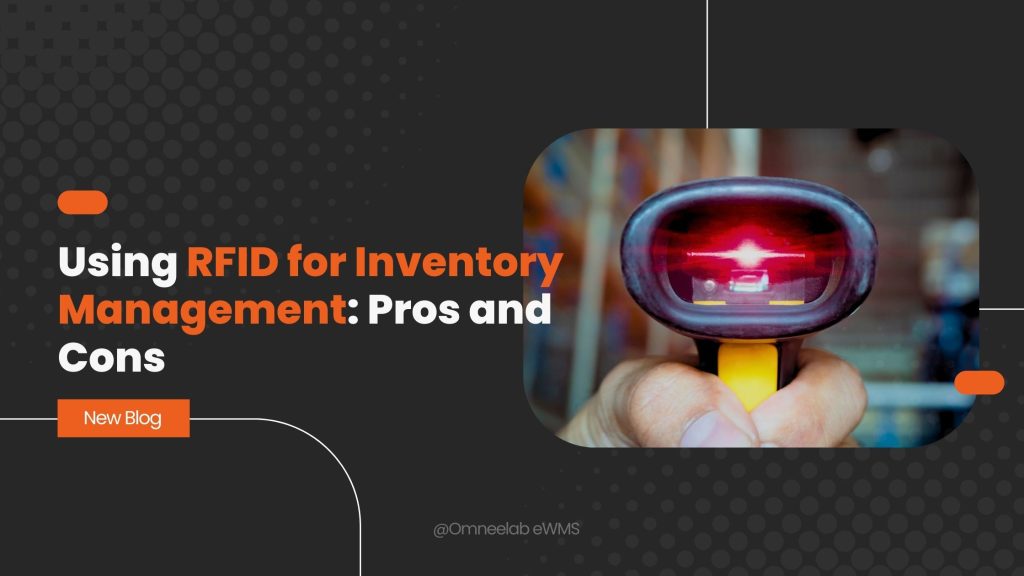Imagine running a business where your inventory is always accurate, easily trackable, and seamlessly managed. Sounds ideal, right? Enter RFID technology in inventory management—a modern solution that’s transforming how businesses track and manage their stock.
Whether you’re running a retail store, a warehouse, or a supply chain operation, inventory management can be a daunting task. Manual processes are time-consuming, prone to error, and can lead to costly mistakes. This is where using RFID for inventory management comes in, offering speed, accuracy, and efficiency. But is RFID the perfect solution for inventory tracking?
Like any technology, it has its advantages and disadvantages. In this article, we’ll dive into the pros and cons of RFID, exploring how it works, how it can benefit your business, and the challenges you might face when implementing it.

What Is RFID and How Does It Work?
RFID (Radio Frequency Identification) is a technology that uses radio waves to identify and track objects. At its core, an RFID system consists of three main components:
- RFID Tags: These are small devices attached to inventory items. Each tag contains a microchip and an antenna that stores and transmits data.
- RFID Readers: Devices that communicate with the tags using radio waves to collect the data stored in them.
- Software Systems: Programs that process the information collected by the readers and integrate it into inventory databases.
Unlike traditional barcode systems, RFID doesn’t require direct line-of-sight scanning. This allows for high-speed inventory tracking and greater efficiency in managing inventory.
The Pros of Using RFID for Inventory Management
1. Improved Inventory Accuracy
One of the biggest advantages of RFID inventory tracking is its ability to improve inventory accuracy. RFID tags can be scanned automatically, reducing the chances of human error. Businesses report accuracy rates of up to 99% when using RFID compared to 60%-80% with manual tracking methods.
2. Enhanced Efficiency and Speed
With RFID, you can scan multiple items at once—no need to scan individual barcodes one by one. This capability significantly speeds up processes like stock counting, restocking, and shipping. Warehouse employees can complete tasks in minutes rather than hours.
3. Real-Time Visibility
RFID provides store inventory visibility in real-time. This means businesses can know exactly where their inventory is at any given moment. For example, if a product is misplaced in a warehouse, RFID can quickly locate it without the need for manual searching.
4. Cost Savings Over Time
While the initial investment in RFID may be high, the long-term savings can be substantial. Improved accuracy reduces losses due to misplaced or missing inventory, while greater efficiency cuts labor costs.
5. Scalability
As businesses grow, their inventory management needs become more complex. RFID systems for inventory are highly scalable, making them ideal for companies anticipating growth. You can add new tags, readers, and software features as needed.
6. Improved Customer Experience
Accurate inventory means fewer out-of-stock situations and faster order fulfillment. For retailers, this translates into happier customers and improved brand loyalty.
Learn how QR Code for Inventory Management & Warehouse Operations offers a simpler, cost-effective alternative to RFID.
The Cons of Using RFID for Inventory Management
1. High Initial Costs
Implementing RFID systems requires a significant upfront investment. The cost of RFID tags, readers, and software can add up quickly, especially for businesses with large inventories. While prices have decreased in recent years, RFID is still more expensive than traditional barcode systems.
2. RFID Implementation Challenges
Deploying RFID technology is not without its challenges. Some businesses face technical difficulties integrating RFID into their existing inventory management practices. Additionally, poor planning or lack of expertise can lead to implementation delays and increased costs.
3. Environmental Limitations
RFID systems can be affected by environmental factors. For example, metal surfaces and water can interfere with radio waves, reducing the accuracy of RFID tags and scanning. Businesses in industries like food or electronics may need specialized tags to overcome these challenges.
4. Privacy and Security Concerns
RFID technology is not immune to security risks. Unauthorized readers can potentially access sensitive data stored in RFID tags, posing a threat to inventory security. To mitigate this, businesses must invest in encryption and other protective measures.
5. Maintenance Requirements
RFID systems require ongoing maintenance to function properly. Readers, tags, and software all need regular updates and occasional repairs, which adds to the operating costs.
6. Not Always Cost-Effective for Small Businesses
For smaller businesses with limited inventory, the benefits of RFID may not outweigh the costs. In such cases, traditional barcode systems may be a more practical and affordable option.
Comparing RFID to Traditional Barcode Systems
To better understand the benefits and challenges of RFID, let’s compare it to traditional barcode systems:
| Feature | RFID | Barcode |
| Scanning Method | No direct line of sight required | Direct line of sight needed |
| Scanning Speed | High-speed, multiple items at once | One item at a time |
| Accuracy | Up to 99% | Lower accuracy due to manual errors |
| Cost | Higher upfront costs | Lower initial costs |
| Durability | More durable RFID tags | Barcodes can fade or tear |
While barcodes may still be suitable for some businesses, RFID offers clear advantages in terms of speed, accuracy, and scalability.
Use Cases: Where RFID Shines
Retail
Retailers like Walmart and Zara have embraced RFID to enhance store inventory visibility and streamline the shopping experience. RFID enables them to track items from the warehouse to the store floor, reducing out-of-stock situations.
Warehousing and Logistics
In warehouses, RFID improves inventory accuracy and speeds up processes like order picking and shipping. RFID readers can scan entire pallets of goods in seconds, saving valuable time.
Healthcare
Hospitals use RFID to track medical supplies, equipment, and even patients. This ensures that critical items are always available when needed and reduces waste.
How to Successfully Implement RFID Technology
If you’re considering using RFID for inventory management, here are some tips for a smooth implementation:
- Conduct a Cost-Benefit Analysis: Assess whether the long-term benefits of RFID outweigh the initial costs for your business.
- Start Small: Begin with a pilot program to test the technology on a smaller scale before rolling it out company-wide.
- Choose the Right Tags and Readers: Select tags and readers that are compatible with your inventory and environment. For example, specialized tags may be needed for metal or liquid-rich environments.
- Train Your Team: Educate employees on how to use RFID systems effectively. This includes training them to handle potential RFID implementation challenges.
- Monitor and Optimize: Continuously monitor the performance of your RFID system and make adjustments as needed to maximize efficiency.
Conclusion
RFID technology in inventory management offers numerous benefits, from improved accuracy and efficiency to real-time visibility and scalability. However, it’s not without its challenges, including high upfront costs, implementation hurdles, and potential security risks. For businesses with large or complex inventories, RFID can be a game-changer. But for smaller businesses, it may not always be the most cost-effective solution.
As technology continues to evolve, RFID is becoming more accessible and affordable, making it an attractive option for businesses looking to modernize their operations. If you’re ready to take your inventory management to the next level, why not explore how AI tools can further enhance your business processes? AI-driven inventory systems can complement RFID technology, providing powerful insights and automation capabilities.
FAQs
RFID (Radio Frequency Identification) is a system that uses radio waves to track and manage inventory in real time. Each item is tagged with an RFID tag that stores data, which is then scanned by an RFID reader—no need to point or line up like with barcodes. This makes tracking inventory faster, easier, and much more accurate.
The pros of RFID include improved accuracy (up to 99%), faster inventory tracking, real-time visibility into stock levels, and scalability for growing businesses. However, some RFID implementation challenges include high initial costs, maintenance requirements, and potential interference from environmental factors like metal or water.
RFID technology eliminates manual errors often associated with traditional inventory methods. By enabling high-speed inventory tracking, RFID allows businesses to scan multiple items simultaneously without needing to handle each one individually. This saves time, reduces labor costs, and ensures that inventory counts are accurate in real-time.
While RFID systems for inventory offer significant benefits, they may not always be cost-effective for small businesses due to high upfront costs. However, as RFID technology becomes more affordable, some small businesses with complex inventory needs are beginning to adopt it. For smaller operations, traditional barcode systems may still be a more practical choice.
Industries like retail, warehousing, logistics, and healthcare benefit greatly from RFID technology in inventory management. For example, retailers use RFID for store inventory visibility, while warehouses use it to streamline shipping and receiving. In healthcare, RFID helps track medical supplies and equipment, ensuring availability and reducing waste.

Kapil Pathak is a Senior Digital Marketing Executive with over four years of experience specializing in the logistics and supply chain industry. His expertise spans digital strategy, search engine optimization (SEO), search engine marketing (SEM), and multi-channel campaign management. He has a proven track record of developing initiatives that increase brand visibility, generate qualified leads, and drive growth for D2C & B2B technology companies.